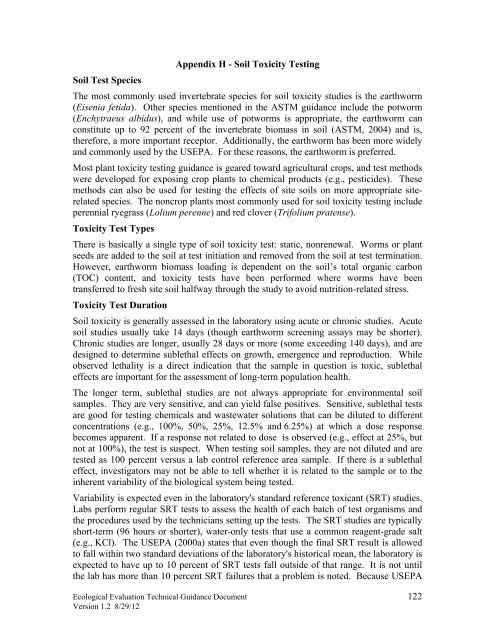Ecological Evaluation Technical Guidance - State of New Jersey
Ecological Evaluation Technical Guidance - State of New Jersey
Ecological Evaluation Technical Guidance - State of New Jersey
- No tags were found...
You also want an ePaper? Increase the reach of your titles
YUMPU automatically turns print PDFs into web optimized ePapers that Google loves.
Appendix H - Soil Toxicity TestingSoil Test SpeciesThe most commonly used invertebrate species for soil toxicity studies is the earthworm(Eisenia fetida). Other species mentioned in the ASTM guidance include the potworm(Enchytraeus albidus), and while use <strong>of</strong> potworms is appropriate, the earthworm canconstitute up to 92 percent <strong>of</strong> the invertebrate biomass in soil (ASTM, 2004) and is,therefore, a more important receptor. Additionally, the earthworm has been more widelyand commonly used by the USEPA. For these reasons, the earthworm is preferred.Most plant toxicity testing guidance is geared toward agricultural crops, and test methodswere developed for exposing crop plants to chemical products (e.g., pesticides). Thesemethods can also be used for testing the effects <strong>of</strong> site soils on more appropriate siterelatedspecies. The noncrop plants most commonly used for soil toxicity testing includeperennial ryegrass (Lolium perenne) and red clover (Trifolium pratense).Toxicity Test TypesThere is basically a single type <strong>of</strong> soil toxicity test: static, nonrenewal. Worms or plantseeds are added to the soil at test initiation and removed from the soil at test termination.However, earthworm biomass loading is dependent on the soil’s total organic carbon(TOC) content, and toxicity tests have been performed where worms have beentransferred to fresh site soil halfway through the study to avoid nutrition-related stress.Toxicity Test DurationSoil toxicity is generally assessed in the laboratory using acute or chronic studies. Acutesoil studies usually take 14 days (though earthworm screening assays may be shorter).Chronic studies are longer, usually 28 days or more (some exceeding 140 days), and aredesigned to determine sublethal effects on growth, emergence and reproduction. Whileobserved lethality is a direct indication that the sample in question is toxic, sublethaleffects are important for the assessment <strong>of</strong> long-term population health.The longer term, sublethal studies are not always appropriate for environmental soilsamples. They are very sensitive, and can yield false positives. Sensitive, sublethal testsare good for testing chemicals and wastewater solutions that can be diluted to differentconcentrations (e.g., 100%, 50%, 25%, 12.5% and 6.25%) at which a dose responsebecomes apparent. If a response not related to dose is observed (e.g., effect at 25%, butnot at 100%), the test is suspect. When testing soil samples, they are not diluted and aretested as 100 percent versus a lab control reference area sample. If there is a sublethaleffect, investigators may not be able to tell whether it is related to the sample or to theinherent variability <strong>of</strong> the biological system being tested.Variability is expected even in the laboratory's standard reference toxicant (SRT) studies.Labs perform regular SRT tests to assess the health <strong>of</strong> each batch <strong>of</strong> test organisms andthe procedures used by the technicians setting up the tests. The SRT studies are typicallyshort-term (96 hours or shorter), water-only tests that use a common reagent-grade salt(e.g., KCl). The USEPA (2000a) states that even though the final SRT result is allowedto fall within two standard deviations <strong>of</strong> the laboratory's historical mean, the laboratory isexpected to have up to 10 percent <strong>of</strong> SRT tests fall outside <strong>of</strong> that range. It is not untilthe lab has more than 10 percent SRT failures that a problem is noted. Because USEPA<strong>Ecological</strong> <strong>Evaluation</strong> <strong>Technical</strong> <strong>Guidance</strong> Document 122Version 1.2 8/29/12
















